Daily Business Report-Aug. 5, 2019
As the bullet train project gasps for air, more diversions of voter-approved bullet train bonds may be in the offing.
Commentary:
Derailing the bullet train
The plan now gaining traction in the Legislature would acknowledge reality and could hasten an end for the ill-conceived, mismanaged bullet train, even Gov. Gavin Newsom’s much-abbreviated version.
By Dan Walters | CALmatters Columnist
A decade ago, shortly after California voters narrowly approved a $9.95 billion bond issue to finance a statewide bullet train system, an official involved in early planning for the project confided a dirty little secret.
While a 200-mile-per-hour bullet train was the sizzle sold to voters, he told me, the unspoken motive was getting more money to expand commuter transit services in the San Francisco Bay Area and Southern California without having to directly ask voters.
The bond issue set aside $950 million for such auxiliary transit systems on the theory that they would feed passengers into a bullet train system.
By and by, as construction of the initial bullet train segment in the San Joaquin Valley stalled due to mismanagement, cost overruns and stiff local opposition, advocates of the regional urban transit projects began to chip off pieces of the other $9 billion in bonds that voters had approved.
The most aggressive raids were led by sponsors of upgrading the Caltrain service between San Francisco and San Jose from diesel-powered trains to electrification – especially after bullet train officials stopped trying to build a separate line down the San Francisco Peninsula due to adamant local opposition and agreed to “blend” with Caltrain.
An amendment to the 2012 state budget allowed bond money to be used for “bookend” projects, meaning Caltrain and Southern California’s Metrolink service, and a 2016 bill, patched together in the final days of that year’s legislative session, legitimized the raid on bullet train funds even further.
Now, as the bullet train project gasps for air, more diversions of voter-approved bullet train bonds may be in the offing.
Gov. Gavin Newsom says he wants to concentrate on finishing the San Joaquin Valley segment, with extensions to Bakersfield and Merced, which would cost about $20 billion, and then connect it to the Bay Area via conventional rail service. A train that now runs between San Jose and Stockton, known as the Altamont Express, would be extended to Merced.
However, the Los Angeles Times reported last week, “Key California lawmakers have devised a plan to shift billions of dollars from the Central Valley bullet train to rail projects in Southern California and the Bay Area, a strategy that could crush the dreams of high-speed rail purists.
“Assembly Democrats see greater public value in improving passenger rail from Burbank to Anaheim, relieving congestion on the busy Interstate 5 corridor before the 2028 Summer Olympics in Los Angeles and putting additional money into San Francisco commuter rail.”
Improving transit in the state’s most congested urban areas, advocates of the new scheme contend, is more important than the patched-together system that Newsom has proposed.
“I like the concept,” Assembly Speaker Anthony Rendon told The Times. “Any project that doesn’t have a significant amount of service to the largest areas in the state doesn’t make much sense.”
It’s difficult to argue with that logic, especially since the bullet train project has utterly failed to attract the many tens of billions of dollars needed to become a reality.
Were the new legislative proposal to prevail, one presumes that the current construction, running from Chowchilla to an orchard near Shafter, would be completed and used for regular-speed Amtrak service. But it would leave Fresno and other San Joaquin Valley cities without the high-speed service they had once been promised.
The plan now gaining traction in the Legislature would acknowledge reality and could hasten an end for the ill-conceived, mismanaged bullet train, even Newsom’s much-abbreviated version.
It’s about time.
CALmatters is a public interest journalism venture committed to explaining how California’s state Capitol works and why it matters. For more stories by Dan Walters, go to calmatters.org/commentary
___________________
California influence industry grows
Companies, unions, trade groups, and other entities seeking to influence policy and legislation spent $187 million in the first half of 2019 as Gavin Newsom formed his new administration. That’s a $10 million jump from the year before, public filings show.
The $187 million was spent on in-house lobbyists, outside lobby firms and other expenses to influence legislation and public policy. It compares with:
- $146 million spent by lobbyist employers in the first two quarters of Gov. Jerry Brown’s administration in 2011.
- $107.7 million in the first two quarters of Arnold Schwarzenegger’s administration in 2004.
Top five spenders in the first half of 2019:
- California Teachers Association, $4.3 million. It focused on legislation to weaken charter public schools, most of which are nonunion.
- Western States Petroleum Association, $4.1 million. It focused on legislation and policy related to oil, emissions and taxation.
- Chevron, $3.7 million. See Western States Petroleum Association.
California State Council of Service Employees, $2.2 million. Labor
- ACLU, $2.19 million. It focused on criminal justice issues and police use of force.
The biggest spenders change little from year to year. Perhaps most noteworthy is the number of entities that hire lobbyists in Sacramento.
In the first half of 2019, 164 employers spent at least $200,000 on lobbying.
That was up from 126 at the start of Brown’s administration, and 86 at the start of Schwarzenegger’s time in office.
— Dan Morain, CALmatters
___________________
Badiee Development starts
construction on Carlsbad Innovate
Badiee Development has started construction on Carlsbad Innovate, the firm’s latest industrial development located in the Carlsbad Oaks North Business Park in Carlsbad. The freestanding building, which will provide 50,150 square feet of customizable high-tech office, warehouse and creative space, is slated for completion in 2020.
Carlsbad Innovate is located on a 4.3-acre parcel at 2810 Caribou Court, Carlsbad. Ted Cuthbert and Conor Boyle of Colliers International San Diego Region are handling leasing efforts.
___________________
County recruits interns
with intellectual disabilities
A new County initiative is creating 20 paid internships for people with intellectual disabilities.
Jay’s Program was named after an intern in Supervisor Nathan Fletcher’s office. On Friday, potential interns were invited to an Employer Social, where they met representatives of many County departments to learn what they do and ask questions about available positions.
The County is collaborating with Partnerships With Industry and the San Diego Workforce Partnership for recruitment and funding of the internship program, which supports the County’s efforts to maintain a diverse and inclusive workforce.
___________________
Insurance commissioner delays
calendar release after more revelations
Insurance Commissioner Ricardo Lara’s office will delay disclosure of the commissioner’s calendar or records of his meetings with insurance companies to August 31, according to a communication sent to Consumer Watchdog.
Lara said that he would disclose his calendars in response to revelations that he took $54,300 in campaign contributions from insurance executives and their spouses, took actions that benefited the insurance company connected to three of those donors, and met with the company’s CEO.
The delay comes after a new report in the San Diego Union-Tribune that Lara’s Department of Insurance was the source of legislation that will benefit a pet insurance company connected to the fourth donor. The bill, AB 1535, was signed by Gov. Gavin Newsom last Wednesday.
___________________
24-year-old SDSU grad raises
$5 million for college startup CourseKey
Local tech startup CourseKey, first launched by a teenager at San Diego State University, has raised $5 million from venture capitalists to grow its software business.
Founder Luke Sophinos, now 24 years old, said the new cash brings CourseKey’s total investments to $9 million since the company’s inception in 2015. Now, the company is equipped to build out its software into a more useful suite of tools for colleges, universities and other learning institutions.
__________________________________________________________________________________

Research team develops soft robotic lens
whose movements are controlled by the eyes
A research team led by the University of California San Diego has developed a soft robotic lens whose movements are controlled by the eyes—blink twice and the lens zooms in and out; look left, right, up or down and the lens will follow.
The lens is the first example of an interface between humans and soft machines. “The human-machine interface, as we know it, features classical machines: computers, wheelchairs, and rigid robotics, for example. The innovation here is the interface with soft robotics. This can really open up new opportunities in the field,” said Shengqiang Cai, a professor of mechanical and aerospace engineering at UC San Diego who led the research.
Potential applications of the system include visual prostheses, adjustable glasses, VR, and soft robots that can see.



